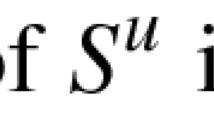Abstract
We study random-self-reductions from a structural complexity-theoretic point of view. Specifically, we look at relationships between adaptive and nonadaptive random-self-reductions. We also look at what happens to random-self-reductions if we restrict the number of queries they are allowed to make. We show the following results:
-
∘ There exist sets that are adaptively random-self-reducible but not nonadaptively random-self-reducible. Under plausible assumptions, there exist such sets inNP.
-
∘ There exists a function that has a nonadaptive (k(n)+1)-random-self-reduction but does not have an adaptivek(n)-random-self-reduction.
-
∘ Forany countable class of functionsC andany unbounded functionk(n), there exists a function that is nonadaptivelyk(n)-uniformly-random-self-reducible but is not inC/poly. This should be contrasted with Feigenbaum, Kannan, and Nisan's theorem that all nonadaptively 2-uniformly-random-self-reducible sets are inNP/poly.
Similar content being viewed by others
References
M. Abadi, J. Feigenbaum, andJ. Kilian, On Hiding Information from an Oracle.Journal of Computer and System Sciences 39 (1989), 21–50.
L. Babai, Random oracles separate PSPACE from the polynomial-time hierarchy.Information Processing Letters 26 (1987), 51–53.
L. Babai, L. Fortnow, andC. Lund. Non-deterministic exponential time has two-prover interactive protocols.Computational Complexity 1 (1991), 3–40.
D. Beaver andJ. Feigenbaum, Hiding instances in multioracle queries. InProceedings of the 7th Symposium on Theoretical Aspects of Computer Science, Lecture Notes in Computer Science, volume 415, Springer-Verlag, 1990, 37–48.
D. Beaver, J. Feigenbaum, J. Kilian, andP. Rogaway, Security with low communication overhead. InAdvances in Cryptology—CRYPTO '90, Lecture Notes in Computer Science, volume 537, Springer-Verlag, 1991, 62–76.
R. Beigel, M. Bellare, J. Feigenbaum, andS. Goldwasser, Languages that are Easier than their Proofs. InProceedings of the 32nd Symposium on Foundations of Computer Science (1991), IEEE Computer Society, 19–28.
M. Blum andS. Kannan, Designing programs that check their work.Journal of the ACM, to appear. Extended abstract inProceedings of the 21st Symposium on the Theory of Computing (1989), ACM, 86–97.
M. Blum, M. Luby, andR. Rubinfeld, Self-testing/correcting with applications to numerical problems.Journal of Computer and System Sciences 47 (1993), 549–595.
M. Blum andS. Micali, How to generate cryptographically strong sequences of pseudo-random bits.SIAM Journal on Computing 13 (1984), 850–864.
J. Feigenbaum, Locally Random Reductions in Interactive Complexity Theory. InAdvances in Computational Complexity Theory, DIMACS Series in Discrete Mathematics and Theoretical Computer Science, volume 13, AMS, 1993, 73–98.
J. Feigenbaum andL. Fortnow, Random-self-reducibility of complete sets.SIAM Journal on Computing 22 (1993), 994–1005.
J. Feigenbaum, L. Fortnow, C. Lund, andD. Spielman,The Power of Adaptiveness and Additional Queries in Random-Self-Reductions. AT&T Bell Laboratories Technical Memorandum, January, 1992.
J. Feigenbaum, S. Kannan, andN. Nisan, Lower bounds on random-self-reducibility. InProceedings of the 5th Structure in Complexity Theory Conference (1990), IEEE Computer Society, 100–109.
S. Goldwasser andS. Micali, Probabilistic encryption.Journal of Computer and System Sciences 28 (1984), 270–299.
S. Goldwasser, S. Micali, andC. Rackoff, The knowledge complexity of interactive proof-systems.SIAM Journal on Computing 18 (1989), 186–208.
E. Hemaspaandra, A. Naik, M. Ogiwara, andA. Selman, P-Selective Sets, and Reducing Search to Decision vs. Self-Reducibility. Submitted for journal publication. Preliminary version, by A. Naik, M. Ogiwara, and A. Selman, inProceedings of the 8th Structure in Complexity Theory Conference (1993), IEEE Computer Society, 52–64.
R. Lipton, New directions in testing. InDistributed Computing and Cryptography, DIMACS Series in Discrete Mathematics and Theoretical Computer Science, volume 2, AMS, 1991, 191–202.
C. Lund, L. Fortnow, H. Karloff, andN. Nisan, Algebraic methods for interactive proof systems.Journal of the ACM 39 (1992), 859–868.
A. Shamir, IP=PSPACE.Journal of the ACM 39 (1992), 869–877.
M. Tompa andH. Woll, Random-self-reducibility and zero-knowledge interactive proofs of possession of information. InProceedings of the 28th Symposium on Foundations of Computer Science (1987), IEEE Computer Society, 472–482.
Author information
Authors and Affiliations
Rights and permissions
About this article
Cite this article
Feigenbaum, J., Fortnow, L., Lund, C. et al. The power of adaptiveness and additional queries in random-self-reductions. Comput Complexity 4, 158–174 (1994). https://doi.org/10.1007/BF01202287
Received:
Issue Date:
DOI: https://doi.org/10.1007/BF01202287



